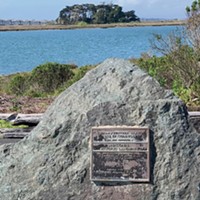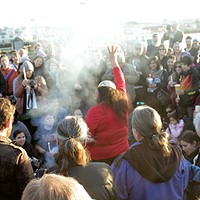Sympathy for the Brownfield
Indian Island is a model among cleanup projects on Humboldt Bay, in more ways than one
By Heidi Walters[
{
"name": "Top Stories Video Pair",
"insertPoint": "7",
"component": "17087298",
"parentWrapperClass": "fdn-ads-inline-content-block",
"requiredCountToDisplay": "1"
}
]
A skinny trail traces the edge of a long willow thicket studded with cypress and a few tall eucalyptus trees on the northeast side of where State Route 255 lands briefly, between bridges, on Indian Island. The trail is hidden from passersby on the road above; indeed, one wouldn't think to even look for a trail there, because the island in the middle of Humboldt Bay is off-limits to all but the handful of dwellers with private residences, reached by boat, along the shore facing Eureka, or those with official permission from the Wiyot Tribe, the U.S. Fish and Wildlife Service or the City of Eureka, the other landowners.
One day in mid-July, the tribe's Environmental Director, Stephen Kullmann, was walking along this trail -- which is on the Wiyot's 60-plus acres, northeast of the highway -- scoping out the homeless camps recently discovered in the thicket. A week before, Eureka Police Lt. Murl Harpham had come out here and issued citations to everyone living in the five sprawling camps, and they'd scattered, leaving behind wastelands of trash, old clothing, tarps and other crap.
Up ahead of Kullmann, a dog was suddenly barking. Then William emerged from the bushes: a young man with a reddish beard and mustache and spacey large blue eyes. He wore a dirty white kerchief tied around his neck, dark pants and dirty Bear River Casino sweatshirt and white sneakers. He said hello, and from behind him, kneeling in the path restraining the dog, his fiancee, Heather, also said hi. She tied the dog to a bush and joined William.
She was pretty, with her hair pulled up into a soft bun, although the right side of her face was ravaged with small red lesions. She had on a blue long-sleeved shirt that said "Aloha" on it, jeans, leather work boots, and she clutched work gloves in one hand. She and William were homeless, and had been living on the island for about a month.
They led Kullmann through the willows, showing him where they'd been scraping masses of camp-leavings into big piles. Heather said they'd made a new camp, off the island, after the police told them to leave, but she and William had been coming back in the daytime to clean up trash left by the others.
"[Harpham] talked to us about the island," said William.
"He told us it was sacred land with the Wiyot," added Heather.
She said she and William had been camped farther up the thicket, and hadn't known there were so many other people in the bushes.
"And then we got the tickets for camping, and I saw all the trash, and it broke my heart," she said. "So we're trying to clean up some of it. I felt I owed it to the Wiyot Tribe, and to this beautiful island."
Kullmann walked back down the trail to where the Sierra Service Project, a volunteer church group comprised of teens and young adults from around the country, was helping him tackle the rest of the mess left by homeless campers.
But this was a mere unexpected sideshow to the real cleanup the tribe's been undertaking for the past 10 years, at the nearby site of the ancient village Tuluwat. For nearly a thousand years some Wiyot families lived at Tuluwat and in another village on the island. The tribe held its annual world renewal ceremony at Tuluwat. But the tribe hasn't occupied the island since Feb. 26, 1860, when white settlers massacred around a hundred Wiyot, mostly women and children, as they slept on the island one night in the midst of their world renewal ceremony.
The island was, and still is, the center of the Wiyots' world. Part of Tuluwat also is an Environmental Protection Agency Brownfield site, its soils drenched with chemicals from a dry dock boat repair facility that operated for 120 years. The tribe bought the contaminated site in 2001, and a few years later was deeded the surrounding 60 acres from the City of Eureka. It wants to restore the damages and resume its world renewal ceremony there.
In some ways, the cleanup ongoing at Indian Island, under an interim remedial action plan (IRAP), resembles many other cleanups around the bay where lumber mills and other industrial operations left toxic hotspots unhealthful to living beings. In other ways, there is no other cleanup like it.
Earlier that July day, at low tide, Kullmann and his volunteers had parked on the shoulder of the highway, descended the bank and, using temporary wood planks, walked past eelgrass-draped rocks and along the muddy shore embedded with gleaming trails of white shell fragments. They crossed a mat of rubbery green-orange pickleweed to a grassy flat and a giant aluminum-sided shed. Beyond the shed was more flat ground and then a massive, shrub-covered mound. Beyond the mound, a broad plain of soggy saltmarsh stretched to the bay and to the road, slashed by manmade ditches and squiggled by natural tidal waterways.
Kullmann opened the shed, pulled out a green flag with the Wiyot Tribe's logo on it, and inserted it into the flagpole slot on a corner of the shed. He brought out tools, and the volunteers got busy clearing the flat ground of brush, which they'd later burn.
The shed is on a 1.5-acre parcel that was most impacted by the dry dock boat repair facility, operated by a succession of owners between 1870 and 1990. The six-acre shell mound it's connected to was created over the nearly thousand years of Wiyot habitation. Robert Gunther owned the island from 1860 to 1924, and built dikes to drain the vast saltmarsh for crops and cattle. He eventually sold some shoreline parcels, upon some of which lumber mills went up. Here at Tuluwat the dry dock boat repair facility was built. Through the years, archaeologists and pothunters plundered the shell mound, which is not only the site of the former village but also a sacred site and a burial ground.
Today, aside from the big metal workshed, which will remain, an old bulkhead at the site tilts into the bay, remains of a foam-filled floating dock disintegrate, and a small wood building stands farther off. In previous years, the tribe's consultants removed other structures, including a paint shed, a winch shed and wayrunners -- wood timbers that went down to the bay and upon which boats were hauled from the water to be worked on. They removed thousands of pounds of metal and old engines and other equipment.
Between the metal shed and the bulkhead is a roughly 50,000-square-foot area where the paint shed and wayrunners were, now covered in black tarp. That's where the most-contaminated soil was found, mostly in the top six inches or so -- paints and pesticides and metals and wood-treatment chemicals and burned oil and other muck. And it's where, last summer, consultants with SHN Consulting Engineers & Geologists removed 17 cubic yards of soil contaminated with high levels of pentachlorophenol (PCP, used in wood treatment solutions back in the day) and associated dioxin (it often is a contaminant of PCP), both highly toxic.
The soil was put in drums and, this year, hauled to a hazardous materials landfill in Utah.
The ground beneath the tarp wasn't uniformly excavated, said Kullmann, explaining the cleanup project on another day out at the island. Based on results of multiple soil samplings, the most contaminated spots were dug up -- carefully, by hand shovel, with a hazardous-waste-trained archaeologist examining every sifted shovelful for human remains and artifacts.
"Normally they would dig out everything and haul it off," Kullmann said. "But this area is so culturally sensitive, they couldn't do that."
Nick Angeloff, an archaeologist who works for the Bear River Tribe and has monitored or reviewed nearly every project around Humboldt Bay to make sure cultural resources are protected, called the Tuluwat cleanup "a model project."
"They want to make sure a child can go out there and shove a handful of dirt in his mouth," he said recently. "They want to make sure artifacts aren't disturbed -- it's the most awful thing in the world to look in the shovel of a backhoe and see a human skull. It just stops everything."
Roland Rueber, an SHN geologist, said samples of the remaining soil at the site were tested, and mostly came out clean or with very low levels of contamination.
"If not, we'd dig a little more and sample," Rueber said. "We only had to do that once. There's still some contaminated soil out there, but it's pretty low."
The next step will be to cap the entire 1.5-acre site -- there are a few other contaminated spots, mostly with varying levels of arsenic, copper, polychlorinated biphenyl (PCBs), polychlorinated hydrocarbons and semi-volatile organic compounds. First, they'll lay down semi-permeable geotextile material -- rainwater will be able to soak in, but plants won't be able to poke up through it nor will animals be able to dig through it. The excavated area will get a special geotextile cover, and then the soil beneath will be injected with an oxidizing solution to neutralize the leftover PCPs and dioxins. Then it will be sampled again to make sure the treatment worked. And then a layer of fill will be placed on that, followed by clean topsoil which will be populated with native plants -- likely the ubiquitous pickleweed and some grasses.
Later, if there is money, the tribe wants to cap the entire shell mound with a geotextile material, to preserve its integrity and protect cultural resources, said Kullmann. In the meantime, at the foot of the cleanup site and around the portion of shell mound exposed to the bay, consultants have been installing carbon-reinforced fiberglass sheet piling, driven several feet into the ground. This revetment, as it's called, will protect the shell mound's edge, which in places has already eroded back a hundred feet by storm waves and boat wakes. It will also keep remaining contaminants in the soil from leaching into the bay, said Kullmann.
The cleanup is part of the tribe's overall Tuluwat cultural and environmental restoration project. Eventually, there will be a dance house, a camp kitchen, a caretaker's residence, a fire ring, an entrance kiosk, dressing rooms, vault toilets and an interpretive trail around the shell mound. It won't be a show-up-whenever-you-like tourist spot; the tribe will host special events, however, and offer tours and such. Visitors will mostly arrive by boat; the project EIR notes that the plan fails to mitigate for poor emergency access to the site. Some wetlands will be destroyed during part of the cleanup, although there'll be a net gain of wetlands in the end.
Despite these and a few other concerns, every one of the myriad local, state and federal agencies overseeing this patch of earth -- the U.S. Army Corps of Engineers, the North Coast Regional Water Quality Control Board, the Humboldt Bay Harbor, Recreation, & Conservation District, the City of Eureka and more -- has issued permits and signed off on the cleanup plan and environmental impact report. And nobody's complained about that.
If you type "Humboldt Bay" into the State Water Resources Control Board's GeoTracker website, it will bring up a map upon which you can look up every cleanup site around the bay -- from leaking underground storage tank sites and former mills to the old railroad balloon track site near the Eureka waterfront and, of course, Indian Island's dry dock boat repair site at Tuluwat.
"There are dots all along the bay, and in the towns around it," said Rueber. "A lot of them are gas stations."
You can click on each site and read whatever's been reported on it, although it's not always up to date: chemical data from monitoring wells and soil samples; regulatory actions and environmental documents detailing the history of the site and plans to clean it up; the status of its assessment and cleanup, and so on. Among other cleanups underway or on the cusp:
There's the old Carson Mill Site ("Samoa Bridge Site" on GeoTracker), an EPA brownfield with low contamination of lead and other metals. Rueber, whose company wrote the cleanup plan, said a bid is currently being circulated for contractors to do remediation work.
"It was also the site of a Wiyot village, so they'll have a cultural monitor out there," he said.
There's the G&R Metals former scrapyard, now owned by Union Pacific Railroad, a four-acre patch of waterfront land between I Street and L Street whose upland soils and offshore sediments are so soaked with lead, zinc, PCBs, arsenic and mercury that the entire parcel is fenced off and posted with "hazardous area" warning signs. It's been sampled and tested and monitored multiple times since the late 1980s, and tons of metal parts and crushed, incinerated cars were removed. Craig Hunt, the regional water board staffer overseeing this site, said UPRR wants to dig up and haul away around 30,000 cubic yards of contaminated soil. "That includes tidal sediments," Hunt said. "In the context of soil removal, this project is really big."
Once it's cleaned up, the city of Eureka wants to turn the site into parkland and build a segment of the coastal trail through it, finally connecting the trail to the boardwalk, according to Miles Slattery, project manager for the City of Eureka's stormwater division.
And then there are sites, like Indian Island, where PCPs and dioxins -- which can cause birth defects and cancer, persist for a long time in the environment, and accumulate in fats as they move up the food chain -- have been detected. The old Simpson Eureka Plywood site (lastly a flea mart) is another. But, actually, the initial cleanup didn't test for dioxins, just PCPs. The watchdog group Humboldt Baykeeper tested a channel on the site that drains to the bay, and discovered high levels of dioxin. It sued Simpson, which then did its own testing and found even higher levels. Under court order, Baykeeper oversaw development of a new cleanup plan for the 2.3-acre site, which was finished this May. It includes dewatering the channel, excavating and removing dioxin-contaminated soil down to a level acceptable under the Clean Water Act, placing an impermeable liner over the excavated area, and putting new soil on top, grading it so it will drain, and revegetating it.
And, not to be forgotten, there's the Balloon Track -- that much-ballyhooed 43-acre former railroad car maintenance, fueling and repair yard between Broadway and Waterfront Drive, now owned by businessman Rob Arkley's Security National subsidiary CUE VI ("Clean Up Eureka"). He wants to develop it into a retail/business park anchored by a Home Depot and flanked by 11 acres of restored wetlands, called Marina Center. The dioxins detected so far have been low-level. It's mainly contaminated with petroleum hydrocarbons, metals and PCBs. And what dioxins there are were likely not created on-site, says Caryn Woodhouse with the regional water board. Besides appearing as a contaminant in PCPs, dioxin can be created by combustion, especially plastics and things made with chlorine. Maybe the old railyard's dioxins came from teepee burner smoke, blown in by the wind. Or from idling diesel engines nearby. Or from backyard burning -- a common source around the country, says Woodhouse.
"Anywhere you look in Eureka you'll find dioxin," Woodhouse said recently by phone. "Anywhere. And the question is how much, and where is it coming from?"
There's been some removal of some contaminated soil, hazardous wastes, storage tanks and oily water already from the site. Now the company is trying to get all of the permits to undertake a supplemental interim remedial action plan (SIRAP), which calls for removal of more debris, targeted excavation of more contaminated soil, site grading and wetlands restoration.
The North Coast Regional Water Quality Control Board approved the project's EIR and interim cleanup plan, and the city of Eureka granted a coastal development permit. But the project has been embroiled in lawsuits -- some by environmental groups, including Baykeeper, who say the cleanup plan and project EIR are inadequate; and one by CUE VI protesting the California Coastal Commission's stepping in to review the project.
The critics complain that the interim cleanup plan doesn't include investigation of deep groundwater and soils below six inches; that soil excavation could stir up the toxics; that wetlands -- project proponents say they're just tire tracks -- could be damaged; and that capping the site just evades "full remediation."
The water board's response to this was to explain that it's an interim remedial action plan, whose elements such as targeted soil excavation and capping were intended to protect sensitive receptors -- any living being that could be affected by the contamination -- while investigation continued to develop alternatives for a final remediation plan. And the supplemental plan was intended to address immediate stormwater runoff concerns.
Another complaint was that the SIRAP hadn't been put out for public review -- until complaining citizens prompted the water board to do so. But normally such interim plans don't go through public review; final remedial action plans do. (Baykeeper Director Pete Nichols did not want to be interviewed for this story, saying his staff attorney, Michelle Smith, would be a better contact. Smith did not respond to our request for an interview.)
Other than that slight variation in the public review process, each of these cleanup sites, though differing in size and contamination, have to undergo the same regulatory process through the water board: a repeating loop of investigation, sampling, characterization, remedial cleanup, monitoring and so on until it's ready for a final cleanup plan.
"The cleanup plans are all a little different," said Rueber. "It depends on the land use, the contamination, who the potential receptors are, and the potential costs."
Yet despite being held to the same process protocols, each plan triggers a different response from the public. Some are praised. Some are challenged. And others -- involving quite nasty cleanups -- are simply ignored. G&R Metals, who's heard of it? Much to the amazement of the city's Miles Slattery, who'd love to get that trail built through there, no one. Simpson Plywood -- OK, perhaps that did point to a slip-up in the investigation process. But after the dioxin presence was affirmed and a new plan drawn up, cleanup moved merrily along.
Indian Island -- that one's obvious. It is the center of the Wiyot world, and the cleanup will allow the return of the world renewal ceremony. It is a national historic landmark. What's not to like? Local companies have donated money, materials, barges and garbage trucks. Even vagabonds and teens feel called upon to help restore it. The site will not be a commercial venture. It is close to our heart.
The Balloon Track, with its Home Depot, you could say is closer to our spleen. It is our place to knee-jerk for or against, our gather-round-and-bicker spot. Its SIRAP has been challenged, it's at loggerheads with the coastal commission over its coastal development permit. This definitely exercises Randy Gans, Security National's Vice President of Real Estate, who chafes that even the Simpson cleanup, which proposes capping off dioxin-contaminated soil at a far higher toxicity level (but within the law) than proposed at the Balloon Track, has now achieved Baykeeper approval.
"My cleanup plan is going to a higher standard than what's required," Gans said recently. "But Simpson's got a good plan -- and they got it done. ... What did the Coastal Commission say when Simpson went in and blew up the dioxin-laden site [to removal contaminated soils]? Not a word."
Slattery said when people challenge one interim cleanup plan, but don't challenge another one, they seem to be saying that the state water board somehow plays favorites -- which exasperates him.
"The state board doesn't act with bias, it treats everyone the same," he said last week by phone. "The fact that some plans are protested and others aren't, you need to look at who's protesting what and why. I don't think a lot of the issues that have been brought up in this area are truly environmental issues. It's more about what the end product is going to be and who wins politically over it."
It may be warmly supported, but the Indian Island cleanup -- which relies on grants and donations to the Wiyot Sacred Site Fund -- has other issues. It needs to find about $300,000 to do the oxidation injection. Until then, the capping is on hold. Other projects also need cash. This September, however, the tribe plans to at least repair the old bulkhead. And when finally the world renewal ceremony is returned, Wiyot elder Cheryl Seidner advises anyone planning to attend one had better leave all bad feelings behind.
"We have no animosity," she said recently. "All people are welcome to come. But if you got angry with your significant other, or someone else, you have to make it right before you come to the ceremony."
Seems like good advice. Renewing, in fact.
Speaking of...
-

Spokespeople Mum as to Who is Behind Mystery Offer for Eureka Schools’ Jacobs Property
Jan 30, 2024 -

The Island Yacht Club
Apr 13, 2023 -

The Tuluwat Island Massacre in its Time
Oct 6, 2022 - More »
Comments (8)
Showing 1-8 of 8
more from the author
-
From the Journal Archives: When the Waters Rose in 1964
- Dec 26, 2019
-
Bigfoot Gets Real
- Feb 20, 2015
-
Lincoln's Hearse
- Feb 19, 2015
- More »
Latest in News
Readers also liked…
-
Through Mark Larson's Lens
A local photographer's favorite images of 2022 in Humboldt
- Jan 5, 2023
-
'To Celebrate Our Sovereignty'
Yurok Tribe to host gathering honoring 'ultimate river warrior' on the anniversary of the U.S. Supreme Court ruling that changed everything
- Jun 8, 2023



































